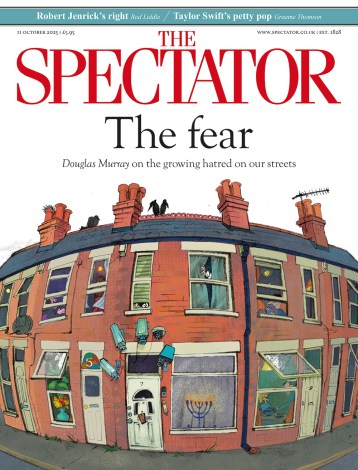Chekhov had no illusions about horticulture (‘It’s a nice, healthy business to be in, but there are passions and wars raging there too’) but even he might have been bemused by the zealotry of our Royal Horticultural Society (RHS) commissars. Last September I enrolled on an RHS Level 2 Certificate in Practical Horticulture. I was hoping to improve my gardening skills and learn more about the propagation of plants to save me forking out a small fortune at garden centres.
Besides, I was tired of relying on my woefully inaccurate plant app to identify rogue forbs on my lawn. You only have to point your plant app at your family to realise the imperfections of the technology: my son is regularly identified as a Malus pumila (apple tree), and my daughter a Cucurbita pepo (field pumpkin); my wife gets off lightly as a Eustoma exaltatum (Texan bluebell).
At the end of our first session the instructor felt it necessary to make us aware that all of us were white
The course would also be my green and pleasant safe space from the divisive world of identity politics and culture wars. Or so I thought. What I hadn’t counted on was the ideology smothering the RHS like bindweed. The UK’s leading garden charity is mulching its very own grievance culture.
There were 15 students at my RHS- approved centre, an even spread of sexes, of all ages from different occupations. Semi-retired, mid-career changers and jobbing gardeners hoping to up their rates by bagging a professional qualification. Each of us paid £1,345 for a three-hour weekly course over nine months and there would be two practical exams in February and June, followed by a multiple choice theory test. This year, for some reason, they have dispensed with the rudiments of vegetable growing, which one disappointed student explained was why he had signed up in the first place.
At the end of our very first session, the course instructor felt it necessary to make us aware that all of us were white. It hadn’t crossed my mind. Or if it had crossed my mind that we were all, to coin a phrase, hideously white I would not have felt the need to articulate it. The consequence was that we were all made to feel awkward, if not a bit shamed. Needless to say, our instructors were also white.
It soon became clear that our instructor had his own misgivings about the RHS’s sense of direction. He was emphasising our whiteness, it transpired, not to guilt-trip us, but to contextualise why so much of the course was devoted to diversity issues. From his perspective, he thought there is a lack of diversity in horticulture because many immigrants come from a semi-agricultural background and do not see it as a progressive, let alone profitable, career. The dearth of diversity is a question of choice as much as a lack of opportunity.
A few years ago, the RHS raised eyebrows after announcing changes to its board membership in order to become more ‘inclusive’. Instead of having to be a member for three years, board members could be elected immediately. It now seems intent on implementing changes from the bottom up.
If you want diversity, you only have to study Linnaeus’s binomials, which is what we were expected to imbibe on a weekly basis. However, even that’s clearly not enough for the RHS. On enrolling we were handed out chunky ring binders which came with an ‘Equality, diversity and inclusion’ (EDI) policy statement. Fine, I thought, this is just a statutory rubric to uphold core values which institutions must now observe.
But no. Every week, it transpired, we would be required to pay obeisance to the gospel of EDI. Or to use RHS speak: ‘There are four overarching qualification wide outcomes that need to be considered for all topics: Health and Safety, Sustainability, Best Practice, and Equality and Diversity.’ To be fair to our instructor, even he was semi-apologetic about having to adhere to the brief. And as you can imagine, he had his work cut out trying to explain the relevance of weeding, say, to equality and diversity. At times it resembled a re-education camp as scripted by Monty Python. Each week became a masterclass in surreal comedy as our instructor struggled to pay lip service to his RHS masters. ‘Are there equality and diversity considerations when hedge-cutting? That is something the RHS must know about. I can’t think of any equality and diversity issues.’
Mulching. ‘Are there any barriers to those involved when mulching? I’ve no idea why mulch would upset people on cultural or religious grounds. The RHS is being over-prescriptive and wants to be seen to be doing the right thing.’ Pruning. ‘Are there any barriers to those involved in pruning?’ The rhetorical prune was left hanging in the air. Leaf cutting. ‘I don’t know any issues that people might have in propagating plants. There could be some obscure reasons.’ Hedge planting. ‘Are there any barriers to those involved? I have no idea.’ Lawn care. ‘There’s nothing controversial there.’

Full marks for honesty. But it wasn’t much help to us when we had to sit the exam. Especially if we were bowled a googly. On exam day, due to adverse weather conditions, we had to sit indoors and do a theory instead of a practical. To our dismay, the test related to the health and safety aspects of mulching. I raised my hand like a schoolboy. ‘Please can I do single digging instead of the theory test?’ It was not an unreasonable demand, I thought, especially as I had signed up to do a practical course. The charming Polish examiner denied my request.
Despite my fatuous answers (‘Don’t eat it’),I miraculously passed. The irony is that even the RHS inevitably falls short when it comes to its own exacting standards. How can it be fair to have candidates undergo a 30-minute tree-planting test if one is a 7st stripling and the other a beefcake? The physically demanding challenge of digging a hole and staking a tree under timed conditions inevitably favours the brawny.
What the RHS course lacked was any element about the mental health benefits of gardening. Rather than wasting time on non-existent diversity issues, it could be more mindful of mindfulness and get back to its roots. And preferably vegetables.







Comments